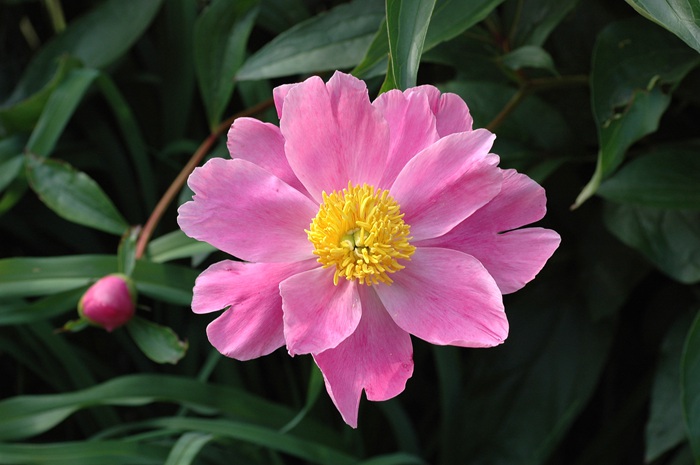- Scientific Name: Paeonia lactiflora Pall.
- Ref: Reise Russ. Reich. 3:286. 1776
- Synonyms:
- Paeonia albiflora Pall.
- P. edulis Salisb.
- P. humei (Sabine) Bailly
- P. lactea Pall.
- P. lactiflora f. nuda (Nakai) Kitag.
- P. lactiflora f. pilosella (Nakai) Kitag.
- P. lactiflora var. villosa M.S.Yan & K.Sun
- P. lobata Pall.
- P. makoya Marnock
- P. officinalis Thunb.
- P. reevesiana (Paxton) Loudon
- P. sinensis Steud.
- P. yui W.P.Fang
- English Common Name: Chinese peony, common garden peony
- Chinese Common Name: 芍药 sháoyào
- Japanese Common Name: シャクヤク [芍薬] shakuyaku
- Family: Paeoniaceae
- Genus: Paeonia
- Distribution: Woods, grasslands; 400–2300 m. S Gansu, Hebei, Heilongjiang, Jilin, Liaoning, Nei Mongol, S Ningxia, Shaanxi, Shanxi [Japan, Korea, Mongolia, Russia (Far East, Siberia)].
- Photo: Baizhang Ridge, Zhejiang
Herbs perennial, to 70 cm tall. Roots thick, attenuate toward tip, to 1.3 cm in diam. Stems glabrous. Proximal leaves 2-ternate; all leaflets decurrent at base, terminal ones often 2- or 3-segmented; leaflets and segments up to 15, lanceolate or ovate-lanceolate, 4.5--16 × 1.5--4.8 cm, sparsely pubescent abaxially, bristly along veins adaxially, margin white cartilaginous denticulate, apex acuminate. Flowers usually several per shoot, both terminal and axillary, sometimes only terminal one developed, single (in wild plants) or double (in cultivated plants), 8--13 cm wide. Bracts 4 or 5, lanceolate, unequal. Sepals 3 or 4, broadly ovate or suborbicular, 1--1.5 × 1--1.7 cm. Petals 9--13, white or pink (in wild plants), or varying in color (in cultivated plants), obovate, 3.5--6 × 1.5--4.5 cm. Filaments yellow, 0.7--1.2 cm; anthers yellow. Disc yellow, annular. Carpels 2--5, green or purple, glabrous or rarely tomentose. Follicles oblong-ellipsoid, 2.5--3 × 1.2--1.5 cm. Fl. May--Jun, fr. Aug. 2n = 10. (Flora of China)
